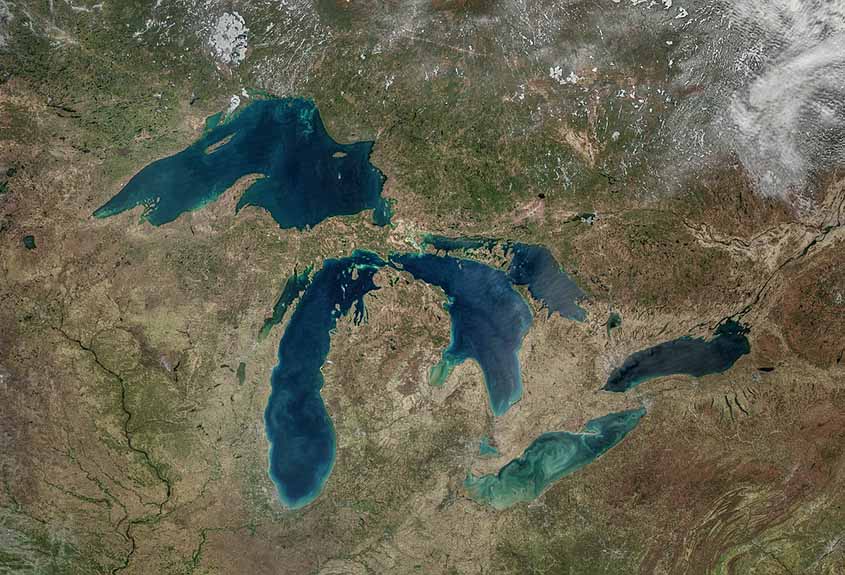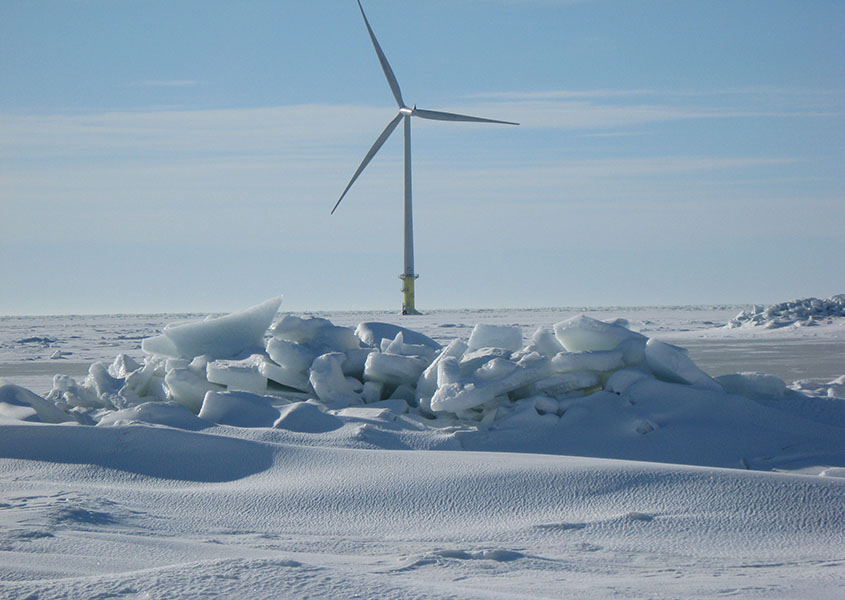Exploring Offshore Wind Energy Opportunities in the Great Lakes
From High-Paying Jobs to a Cleaner Environment, Great Lakes Wind Energy Could Provide Economic Growth for Millions of Regional Residents and Help States Achieve Renewable Energy Targets
The five Great Lakes—Superior, Huron, Michigan, Erie, and Ontario—contain 20% of the planet’s freshwater resources. They provide drinking water to more than 40 million people. And they hold a wealth of wind energy potential.

Wind resource assessments estimate that the Great Lakes’ potential power capacity is 160 gigawatts for fixed-bottom wind turbines and about 415 gigawatts for floating wind energy systems. That wind energy resource potential exceeds the annual electricity consumption in five out of eight of the U.S. states bordering the Great Lakes.
In short, wind energy represents a significant opportunity for the Great Lakes region to transition to clean energy electrification and reap the associated benefits.
To gain a greater understanding of this possibility, as well as the obstacles facing Great Lakes wind energy development, the U.S. Department of Energy’s Wind Energy Technologies Office funded research by National Renewable Energy Laboratory (NREL) staff. The resulting report, Great Lakes Wind Energy Challenges and Opportunities Assessment, defines a comprehensive research program to address these issues and charts a commercial pathway for wind energy in the Great Lakes that begins before 2035.
Opportunity Is the Biggest Takeaway
NREL’s research indicates that the adoption of offshore wind energy could enable states in the Great Lakes region to achieve their clean-energy goals, boost their economies with high-paying jobs, and provide a cleaner environment for residents.
“Wind energy in the Great Lakes is compelling from both a clean energy and an economic growth standpoint,” said NREL researcher Walter Musial, a co-author of the report and the laboratory’s leading expert on offshore wind energy. “The Great Lakes have an abundant wind resource near population centers, and there is a real opportunity for Great Lakes wind energy resources to contribute not only to the region’s clean energy mix and its economic growth but also to achieving long-term national clean energy goals set by the administration.”
One of the most feasible economic benefits to Great Lakes offshore wind energy development is the potential to expand local logistics and supply chains. This includes the development and revitalization of factories, ports, and vessels that meet the needs of the new Great Lakes-based offshore wind energy industry.
Unique Obstacles To Be Faced
According to Musial, the biggest obstacle to developing offshore wind energy in the lakes is the narrow locks of the St. Lawrence Seaway and the Welland Canal. These channels, which extend out to the Atlantic Ocean, are too narrow to accommodate the enormous ocean vessels that are used to install offshore wind turbines.
“Everything has to be brought through the locks or built on the lakes,” Musial said. “For floating offshore wind energy, most of the construction and assembly will need to be administered at a Great Lakes port, similar to what we envision on the ocean. But for fixed-bottom foundations, we must find alternatives to typical ocean-based offshore wind technologies, which require giant installation vessels.”
Another big challenge is freshwater ice, which is stronger than sea ice and more prevalent in the Great Lakes than in Atlantic offshore wind energy sites. The lakes’ annual freshwater surface ice introduces new technological challenges, especially for floating wind turbines, which have not yet been proven under these conditions.
“We don’t think developing floating wind turbines in icy climates will be a massive hurdle, but it hasn’t been done before, so there is a significant amount of uncertainty,” Musial said.

Other deployment issues related to developing wind energy in the Great Lakes could slow the process and potentially increase project capital costs. These include installing the turbines far enough out from shore to mitigate viewshed concerns, environmental issues such as potential bird and bat interactions, and competition with nearby, utility-scale land-based wind and solar energy that is currently less expensive.
“The Great Lakes region is home to millions of human residents and also provides an important habitat for wildlife, including resident and migratory bird and bat species,” said NREL researcher Rebecca Green, a co-author of the report and an offshore wind energy environmental expert. “By taking into account social and environmental concerns now as we conduct the research needed to open the Great Lakes to offshore wind, we can identify and employ risk-minimization solutions and implement low-impact siting and mitigation strategies that help ensure the benefits of wind projects outweigh the costs. For example, siting turbines in deeper waters and farther from shore has the potential to minimize viewshed impacts and may decrease interactions with certain wildlife species.”
Floating Wind Turbines Have Advantages
Depending on the lake, floating offshore wind turbines could have advantages over fixed-bottom turbines, according to Musial.
Here are five reasons why:
- Transportation. Floating offshore wind turbine components can be brought through the seaway and canals and assembled at ports built on the lakes, eliminating the need for big ships. Fixed-bottom wind turbines may be needed in the shallower waters of Lake Erie, but these turbines will likely be smaller because large installation vessels will be unavailable.
- View preservation. Floating structures could be deployed in deeper waters, where they would be less visible from shore.
- Lakebed disruption. Floating structures would avoid most of the risk of disturbing possible contaminants in near-shore lakebed sediments, which have raised concerns about drinking water supplies.
- Ice. The edges of the Great Lakes tend to freeze more solidly and accumulate drifting ice. The lakes do not always freeze in the middle, where floating wind turbines would be deployed. Successful deployment of floating offshore wind turbines in the Great Lakes would require additional research to determine how the machines would respond to seasonal icing.
- Bird and bat activity. Floating wind turbines located miles from shore may reduce the potential for wildlife–turbine interactions for some bird and bat species, though more research is needed.
Making It Happen
Further targeted research is needed to develop an informed Great Lakes wind energy strategy. The NREL research team’s preliminary recommendations to enable deployment of offshore wind in the Great Lakes by 2035 include:
- Assessing site characterization, wind resource, lakebed features, and ice conditions
- Evaluating the capabilities and needs of ports and vessels for installation and maintenance
- Determining how to develop a regional supply chain
- Assessing technology options, capabilities, and needs, including both fixed-bottom and floating systems
- Examining ways to engage the workforce needed to support the development and ongoing maintenance of this new industry
- Estimating project costs
- Developing strategies to monitor and minimize environmental impacts, such as collision risk to birds and bats
- Assessing human-use impacts, including examining viewshed and collaborating with fisheries
- Evaluating regulatory and policy considerations in each state, including offshore leasing processes
- Investigating electric power network points of interconnection, power handling capacity, and transmission expansion plans and needs
- Researching prospective opportunities and synergies with Canadian entities.
“The Great Lakes offer vast opportunities for offshore wind development, and our research is just a starting point,” Musial said. “While there are obstacles to any offshore wind deployment, the Great Lakes’ challenges are unique and need to be addressed. Yet, our study identified no insurmountable barriers that would ultimately render Great Lakes wind energy unfeasible.”
Learn more about NREL’s offshore wind energy research. And be sure to subscribe to NREL’s wind energy newsletter for more news like this.
Last Updated May 28, 2025
